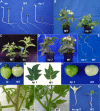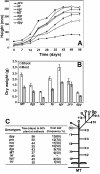Convergence of developmental mutants into a single tomato model system: 'Micro-Tom' as an effective toolkit for plant development research
- PMID: 21714900
- PMCID: PMC3146949
- DOI: 10.1186/1746-4811-7-18
Convergence of developmental mutants into a single tomato model system: 'Micro-Tom' as an effective toolkit for plant development research
Abstract
Background: The tomato (Solanum lycopersicum L.) plant is both an economically important food crop and an ideal dicot model to investigate various physiological phenomena not possible in Arabidopsis thaliana. Due to the great diversity of tomato cultivars used by the research community, it is often difficult to reliably compare phenotypes. The lack of tomato developmental mutants in a single genetic background prevents the stacking of mutations to facilitate analysis of double and multiple mutants, often required for elucidating developmental pathways.
Results: We took advantage of the small size and rapid life cycle of the tomato cultivar Micro-Tom (MT) to create near-isogenic lines (NILs) by introgressing a suite of hormonal and photomorphogenetic mutations (altered sensitivity or endogenous levels of auxin, ethylene, abscisic acid, gibberellin, brassinosteroid, and light response) into this genetic background. To demonstrate the usefulness of this collection, we compared developmental traits between the produced NILs. All expected mutant phenotypes were expressed in the NILs. We also created NILs harboring the wild type alleles for dwarf, self-pruning and uniform fruit, which are mutations characteristic of MT. This amplified both the applications of the mutant collection presented here and of MT as a genetic model system.
Conclusions: The community resource presented here is a useful toolkit for plant research, particularly for future studies in plant development, which will require the simultaneous observation of the effect of various hormones, signaling pathways and crosstalk.
Figures





Similar articles
-
Genome-wide analysis of intraspecific DNA polymorphism in 'Micro-Tom', a model cultivar of tomato (Solanum lycopersicum).Plant Cell Physiol. 2014 Feb;55(2):445-54. doi: 10.1093/pcp/pct181. Epub 2013 Dec 5. Plant Cell Physiol. 2014. PMID: 24319074
-
Micro-Tom Tomato as an Alternative Plant Model System: Mutant Collection and Efficient Transformation.Methods Mol Biol. 2016;1363:47-55. doi: 10.1007/978-1-4939-3115-6_5. Methods Mol Biol. 2016. PMID: 26577780
-
Genetic and physiological characterization of tomato cv. Micro-Tom.J Exp Bot. 2006;57(9):2037-47. doi: 10.1093/jxb/erj154. Epub 2006 May 10. J Exp Bot. 2006. PMID: 16687436
-
Trait discovery and editing in tomato.Plant J. 2019 Jan;97(1):73-90. doi: 10.1111/tpj.14152. Epub 2018 Dec 24. Plant J. 2019. PMID: 30417464 Review.
-
Gibberellin in tomato: metabolism, signaling and role in drought responses.Mol Hortic. 2021 Nov 24;1(1):15. doi: 10.1186/s43897-021-00019-4. Mol Hortic. 2021. PMID: 37789477 Free PMC article. Review.
Cited by
-
The tomato (Solanum lycopersicum cv. Micro-Tom) natural genetic variation Rg1 and the DELLA mutant procera control the competence necessary to form adventitious roots and shoots.J Exp Bot. 2012 Sep;63(15):5689-703. doi: 10.1093/jxb/ers221. Epub 2012 Aug 21. J Exp Bot. 2012. PMID: 22915742 Free PMC article.
-
Promoter replacement of ANT1 induces anthocyanin accumulation and triggers the shade avoidance response through developmental, physiological and metabolic reprogramming in tomato.Hortic Res. 2022 Nov 15;10(2):uhac254. doi: 10.1093/hr/uhac254. eCollection 2023 Feb. Hortic Res. 2022. PMID: 36751272 Free PMC article.
-
Modifications in Organic Acid Profiles During Fruit Development and Ripening: Correlation or Causation?Front Plant Sci. 2018 Nov 20;9:1689. doi: 10.3389/fpls.2018.01689. eCollection 2018. Front Plant Sci. 2018. PMID: 30524461 Free PMC article. Review.
-
Compact tomato seedlings and plants upon overexpression of a tomato chromatin remodelling ATPase gene.Plant Biotechnol J. 2016 Feb;14(2):581-91. doi: 10.1111/pbi.12400. Epub 2015 May 14. Plant Biotechnol J. 2016. PMID: 25974127 Free PMC article.
-
Abscisic acid-deficient sit tomato mutant responses to cadmium-induced stress.Protoplasma. 2017 Mar;254(2):771-783. doi: 10.1007/s00709-016-0989-4. Epub 2016 Jun 4. Protoplasma. 2017. PMID: 27263082
References
-
- Sol Genomics Network. http://solgenomics.net
-
- The C. M Rick Tomato Genetics Resource Center. http://tgrc.ucdavis.edu - PubMed
-
- Scott J, Harbaugh B. Micro-Tom: A miniature dwarf tomato. Florida Agric Exp Station Circular. 1989;370:1–6.
LinkOut - more resources
Full Text Sources

